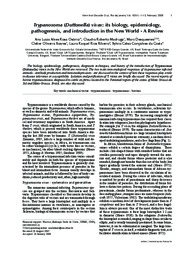Trypanosoma (Duttonella) vivax: its biology, epidemiology, pathogenesis, and introduction in the New World - A review.
Trypanosoma (Duttonella) vivax: its biology, epidemiology, pathogenesis, and introduction in the New World - A review.
Author(s): OSÓRIO, A. L. A. R.; MADRUGA, C. R.; DESQUESNES, M.; SOARES, C. O.; RIBEIRO, L. R. R.; COSTA, S. C. G. da
Summary: The biology, epidemiology, pathogenesis, diagnostic techniques, and history of the introduction of Trypanosoma (Duttonella) vivax in the New World are reviewed. The two main immunological responses of trypanosome-infected animals - antibody production and immunodepression - are discussed in the context of how these responses play a role in disease tolerance or susceptibility. Isolation and purification of T. vivax are briefly discussed. The recent reports of bovine trypanosomiasis diagnosed in cattle on farms located in the Pantanal region of the states of Mato Grosso do Sul and Mato Grosso, Brazil, are also discussed.
Publication year: 2008
Types of publication: Journal article
Unit: Embrapa Beef Cattle
Observation
Some of Embrapa's publications are published as ePub files. To read them, use or download one of the following free software options to your computer or mobile device. Android: Google Play Books; IOS: iBooks; Windows and Linux: Calibre.
Access other publications
Access the Agricultural Research Database (BDPA) to consult Embrapa's full library collection and records.
Visit Embrapa Bookstore to purchase books and other publications sold by Embrapa.

